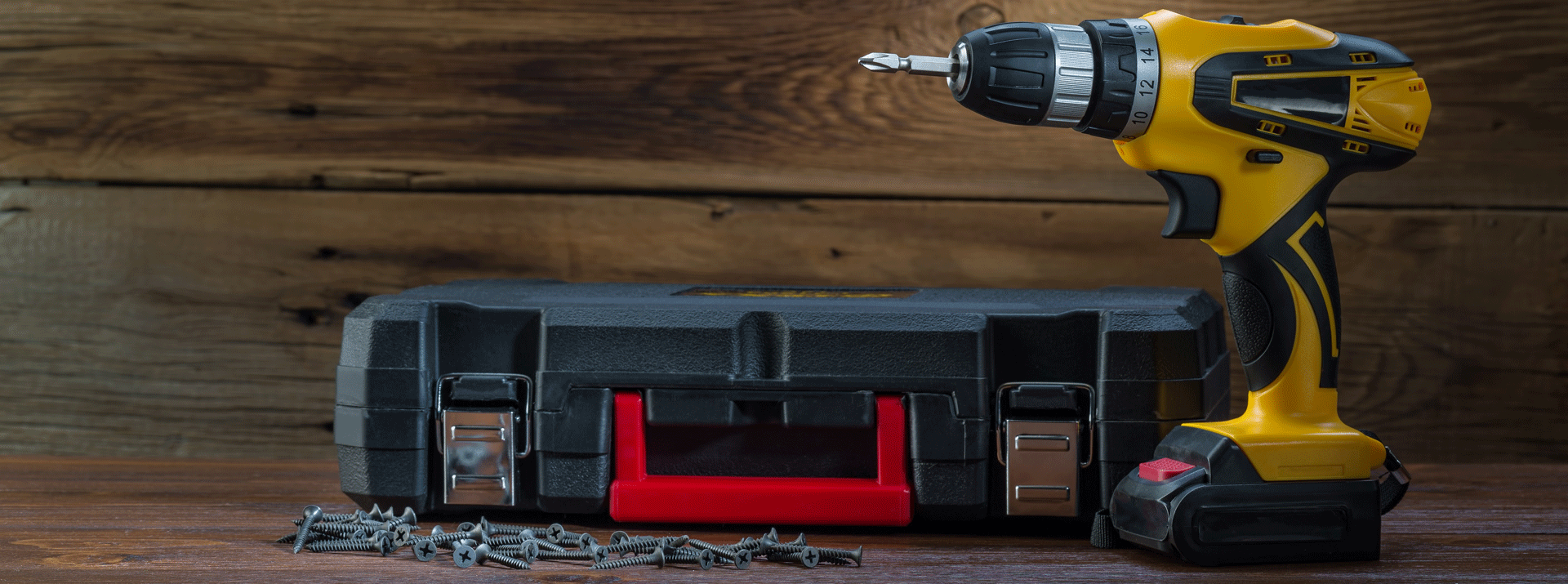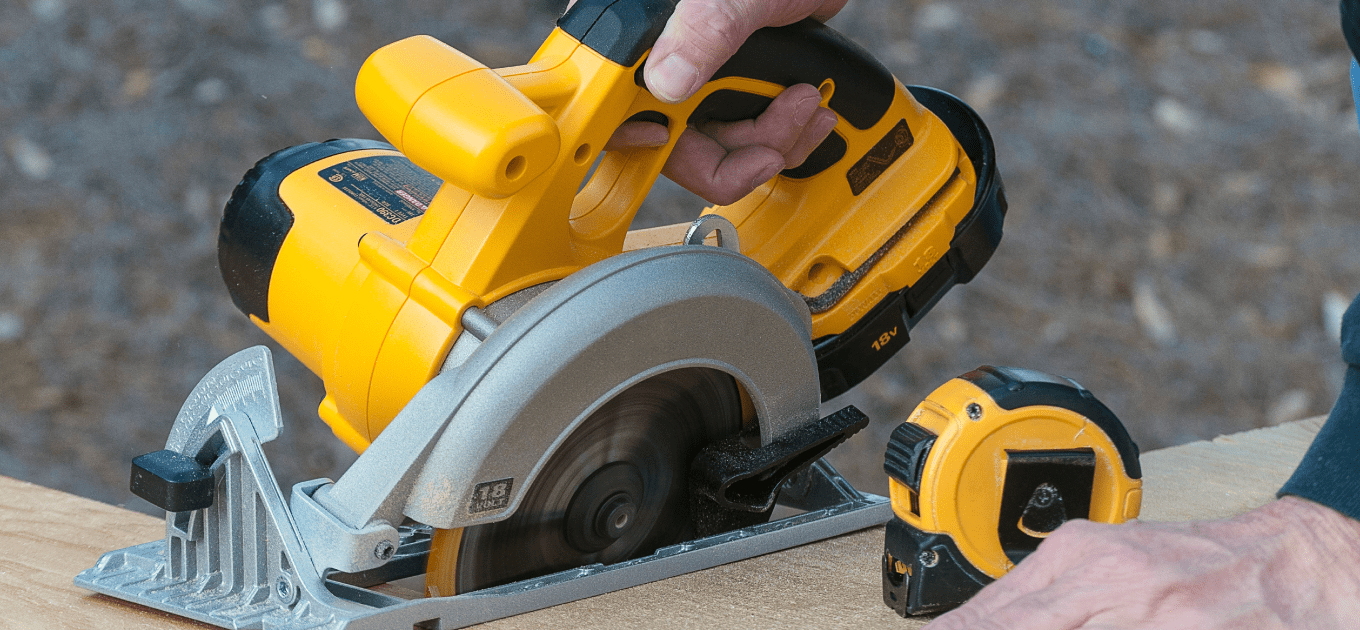
- 電子部品関連
電動工具の発展の歴史とデクセリアルズの表面実装型ヒューズ「セルフコントロールプロテクター(SCP)」
目次
人類の歴史とともにあった「工具の進歩」
工具の進化は、人々の暮らしや産業の発展を支える重要な技術として、時代とともに進化してきました。

「電動ドリル」の歴史——世界初は約130年前に誕生
電動ドリルは、発明当時はドリルを取り付けて木材や金属に穴をあける専用工具として登場しました。その後さまざまな機能追加され、先端に工具のバリエーションが増えることで、穴あけ・締め付け・研磨などの複数作業に対応できるようになりました。
電動ドリルの進化において大きな転機となったのが、1916年にアメリカの世界最大手電動工具メーカーが「ピストルグリップ」をデザインに採用したことです。これにより工具は小型化され、片手で持ち運び可能なスタイルが定着し、トリガー式スイッチの発明は、現在の電動工具の礎になっています。1946年には世界初の家庭用電動ドリルが発売され、DIY(Do It Yourself)という文化の普及にも貢献しました。現在の電動工具に共通する構造や操作性は、100年以上前に登場した電動ドリルの設計を起点としています。

コードレスドリルの発明とリチウムイオンバッテリー搭載工具の登場
1961年、アメリカの電動工具メーカーがニカドバッテリーを搭載した世界初の「コードレスドリル」を開発したことにより、電源コードの制約から解放されたことで、作業の自由度は飛躍的に高まりました。2005年にはリチウムイオンバッテリーを搭載した電動工具が世界で初めて発売され、高出力と長時間駆動の両立が可能となりました。
各国の電動工具メーカーが開発・販売する製品も、定置型・電源コード式からリチウムイオンバッテリー・充電式の電動工具が主流となり、製品ラインナップが一新されることになりました。電圧も12Vから14.4V、18V、さらには36Vへと高電圧化が進んでおり、これにより回路にはより高電流・高付加に耐える設計が求められるようになりました。 コードレス化とリチウムイオンバッテリーの導入により、電動工具は高出力・長時間駆動を実現するようになりました。
高電圧化する電動工具と設計上の課題
近年、電動工具のバッテリーはますます高電圧化が進んでいます。特に欧米メーカーはバッテリーの大容量化および高出力化を目指し、バッテリーパックに多くのセルを搭載する傾向にあります。
ほぼ全ての電動工具は、「18650」と呼ばれる汎用サイズのリチウムイオンバッテリーが使われています。このセルは電池1本当たり約3.6Vの電圧を持っており、複数本を直接に接続することで必要な出力電圧を得る構成になっています。たとえば、4本なら14.4V、5本なら18V、10本なら36Vといったように、常に3.6Vの倍数のバッテリー電圧となるのが特徴です。 電圧が高くなるほど、モーター出力を効率的に高めることが可能になるため、プロ向け電動工具を中心に高電圧モデルの採用が進んでいます。

また、CO2削減を目的とした各国の排気ガス規制により、エンジンで動く工具の利用が制限されつつあります。大容量バッテリーパックを搭載した電動工具は、エンジン動力機器の代替となることが予想されています。ただし、電池の容量(1回の充電で可能な作業量)が向上するわけではありません。
加えて、欧米市場を中心にBluetooth無線通信機能を備えた「スマート電動工具」の導入も進んでいます。トルク(ねじりの強さ)設定の遠隔操作や工具ごとの識別、作業ログの記録といった機能が搭載される一方で、制御回路の複雑化が進んでいます。こうした高機能化により、異常時の遮断や過電流対策など、回路保護設計の重要性はさらに高まっています。 高電圧化やスマート化の進展により、異常時の遮断や信頼性の高い回路設計がより重要になっています。
バッテリーの容量向上に伴い「安全基準」も厳格化
電動工具に搭載されるリチウムイオンバッテリーの大容量化が進む中で、それに比例するように安全設計に対する要求水準も年々高まっています。これは製品ごとの企業姿勢によるものではなく、各国で定められている法規制や国際安全規格の厳格化が背景にあります。
特に、難燃性の国際規格である「UL 62841-1」では、2015年以降リチウムイオンセルおよびバッテリーシステムに関する要求事項が新たに追加されました。 これにより、電動工具の構造設計だけでなく、バッテリーの異常遮断やセル挙動の制御にまで規格対応が求められるようになっています。
加えて、現在、電動工具に搭載されるリチウムイオンセルは、「UL 62133」または「IEC 62133」のいずれかの規格への適合が必須とされています。これらの規格では、セルの充電時に起こりうる異常事象や熱暴走を防ぐため、電圧や電流、構造上の挙動に対して厳しい要件が設けられています。
これらの規格では、リチウムイオンバッテリーシステムの通常充電中、セルが「規定された動作領域(Specified Operating Region)」内にあることが求められています。この領域にとどまっているかどうかを評価する条件として、以下のような要件が定められています。
a) 開回路電圧が試験前の90%以上であること
b) 通常の充電試験・再充電試験に適合していること
c) セルの通気孔に損傷がないこと
この「規定された動作領域」はセルメーカーが定義し、試験・評価の際には電圧も充電電流もその範囲内にとどまっていなければなりません。これは、通常状態だけでなく、工具や充電器が故障した場合にも同様であり、異常発生時にも安全を確保する回路設計が必要とされています。
さらに、UL 62841-1では、発煙があっても爆発しないことを確認する「エンクロージャ圧力試験」や、落下などの衝撃後も安全性が維持されていることを確認する「機械的強度試験」の実施も求められています。
なかでも特に重要とされているのが、「充電回路の部品が故障した場合でも、セルの電圧が上限値を150 mV超過してはならない」という要求です。もしこれを超える場合、そのバッテリーシステムは以降の充電を完全に停止する「永久遮断」状態に移行する必要があります。
安全規格の厳格化により、異常時でも確実に遮断できる保護回路の設計が求められています。
なぜ電動工具の回路保護にSCP(表面実装型ヒューズ)が選ばれているのか?
これまで見てきたように、電動工具の高電圧化・大容量化、さらには安全規格の厳格化といった流れの中で、回路保護部品に求められる性能は大きく変化してきています。こうした設計上の課題に対応するために、デクセリアルズが提供するのが、表面実装型ヒューズ『セルフコントロールプロテクター(SCP)』です。
SCPは、リチウムイオンバッテリーに過充電や過電流が起きたときに、確実に回路を遮断してバッテリーが危険な状態になることを防ぐための表面実装タイプのヒューズ素子であり、次のような特長を備えています。
1.安全性向上:SCPはどのようにして異常時に再使用を防止するのか?
SCPは、異常を検知した際に回路を物理的に遮断する「永久遮断」タイプのヒューズです。これにより、異常が発生したバッテリーパックをそのまま再使用することができなくなり、発煙や発火などの重大事故につながるリスクを未然に防ぐことが可能になります。
2.急速充電可能:SCPは急速充電にどう対応しているのか?
急速充電が求められる電動工具においては、回路全体の電気抵抗を抑えることが重要です。SCPは、通電時の電気抵抗を低く抑えた設計となっており、急速充電時の電力ロスを低減できます。これにより、エンドユーザーの充電待機時間を短縮し、作業効率の向上にもつながります。
3.ヒューズの溶断カーブ制御:なぜSCPはセルの性能限界まで安全に活用できるのか?
SCPは、異常時に内部のヒーターを使ってヒューズエレメントを加熱することで、即座に溶断を行う構造を採用しています。これにより、ヒューズの仕様に関わらず、セルの性能限界まで安全に活用できるようになります。たとえば、「電池の能力を十分に引き出したいが、安全性も担保したい」といった設計ニーズに対して、高い自由度と安全性を両立した回路設計が可能になります。
これらの特長により、SCPは電動工具のような高負荷アプリケーションでも、安定した遮断性能を実現します。(SCPの仕組みに関する詳細はこちらの記事をご覧ください。)今後も、市場拡大のトレンドにある電動工具において、デクセリアルズの表面実装型ヒューズ「セルフコントロールプロテクター(SCP)」はエンドユーザーの皆様の安心・安全に貢献していきます。
関連記事
- SHARE

当社の製品や製造技術に関する資料をご用意しています。
無料でお気軽にダウンロードいただけます。
お役立ち資料のダウンロードはこちら
当社の製品や製造技術に関する資料をご用意しています。
無料でお気軽にダウンロードいただけます。
お役立ち資料のダウンロードはこちら
















